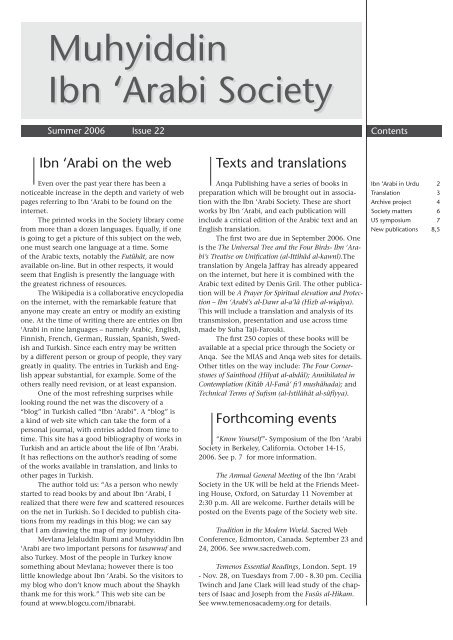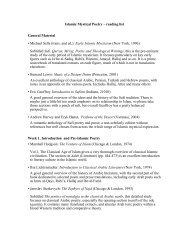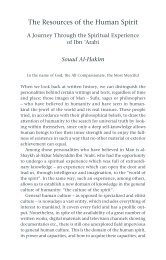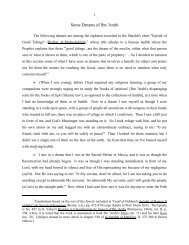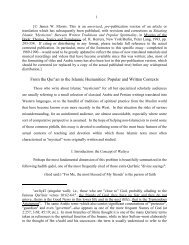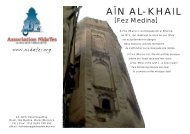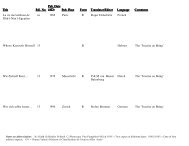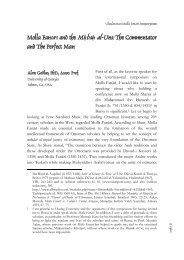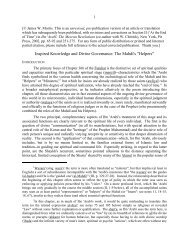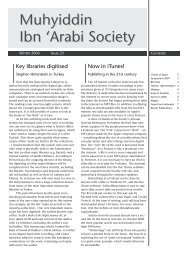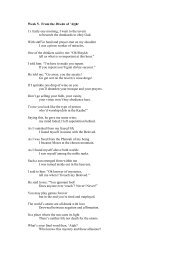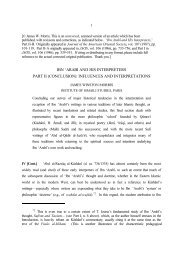Newsletter 22 - Muhyiddin Ibn Arabi Society
Newsletter 22 - Muhyiddin Ibn Arabi Society
Newsletter 22 - Muhyiddin Ibn Arabi Society
Create successful ePaper yourself
Turn your PDF publications into a flip-book with our unique Google optimized e-Paper software.
<strong>Muhyiddin</strong><strong>Ibn</strong> ‘<strong>Arabi</strong> <strong>Society</strong>Summer 2006 Issue <strong>22</strong> Contents<strong>Ibn</strong> ‘<strong>Arabi</strong> on the webEven over the past year there has been anoticeable increase in the depth and variety of webpages referring to <strong>Ibn</strong> ‘<strong>Arabi</strong> to be found on theinternet.The printed works in the <strong>Society</strong> library comefrom more than a dozen languages. Equally, if oneis going to get a picture of this subject on the web,one must search one language at a time. Someof the <strong>Arabi</strong>c texts, notably the Futûhât, are nowavailable on-line. But in other respects, it wouldseem that English is presently the language withthe greatest richness of resources.The Wikipedia is a collaborative encyclopediaon the internet, with the remarkable feature thatanyone may create an entry or modify an existingone. At the time of writing there are entries on <strong>Ibn</strong>‘<strong>Arabi</strong> in nine languages – namely <strong>Arabi</strong>c, English,Finnish, French, German, Russian, Spanish, Swedishand Turkish. Since each entry may be writtenby a different person or group of people, they varygreatly in quality. The entries in Turkish and Englishappear substantial, for example. Some of theothers really need revision, or at least expansion.One of the most refreshing surprises whilelooking round the net was the discovery of a“blog” in Turkish called “<strong>Ibn</strong> ‘<strong>Arabi</strong>”. A “blog” isa kind of web site which can take the form of apersonal journal, with entries added from time totime. This site has a good bibliography of works inTurkish and an article about the life of <strong>Ibn</strong> ‘<strong>Arabi</strong>.It has reflections on the author’s reading of someof the works available in translation, and links toother pages in Turkish.The author told us: “As a person who newlystarted to read books by and about <strong>Ibn</strong> ‘<strong>Arabi</strong>, Irealized that there were few and scattered resourceson the net in Turkish. So I decided to publish citationsfrom my readings in this blog; we can saythat I am drawing the map of my journey.Mevlana Jelaluddin Rumi and <strong>Muhyiddin</strong> <strong>Ibn</strong>‘<strong>Arabi</strong> are two important persons for tasawwuf andalso Turkey. Most of the people in Turkey knowsomething about Mevlana; however there is toolittle knowledge about <strong>Ibn</strong> ‘<strong>Arabi</strong>. So the visitors tomy blog who don’t know much about the Shaykhthank me for this work.” This web site can befound at www.blogcu.com/ibnarabi.Texts and translationsAnqa Publishing have a series of books inpreparation which will be brought out in associationwith the <strong>Ibn</strong> ‘<strong>Arabi</strong> <strong>Society</strong>. These are shortworks by <strong>Ibn</strong> ‘<strong>Arabi</strong>, and each publication willinclude a critical edition of the <strong>Arabi</strong>c text and anEnglish translation.The first two are due in September 2006. Oneis the The Universal Tree and the Four Birds- <strong>Ibn</strong> ‘<strong>Arabi</strong>’sTreatise on Unification (al-Ittihâd al-kawnî).Thetranslation by Angela Jaffray has already appearedon the internet, but here it is combined with the<strong>Arabi</strong>c text edited by Denis Gril. The other publicationwill be A Prayer for Spiritual elevation and Protection– <strong>Ibn</strong> ‘<strong>Arabi</strong>’s al-Dawr al-a’lâ (Hizb al-wiqâya).This will include a translation and analysis of itstransmission, presentation and use across timemade by Suha Taji-Farouki.The first 250 copies of these books will beavailable at a special price through the <strong>Society</strong> orAnqa. See the MIAS and Anqa web sites for details.Other titles on the way include: The Four Cornerstonesof Sainthood (Hilyat al-abdâl); Annihilated inContemplation (Kitâb Al-Fanâ’ fi’l mushâhada); andTechnical Terms of Sufism (al-Istilâhât al-sûfîyya).Forthcoming events“Know Yourself”- Symposium of the <strong>Ibn</strong> ‘<strong>Arabi</strong><strong>Society</strong> in Berkeley, California. October 14-15,2006. See p. 7 for more information.The Annual General Meeting of the <strong>Ibn</strong> ‘<strong>Arabi</strong><strong>Society</strong> in the UK will be held at the Friends MeetingHouse, Oxford, on Saturday 11 November at2:30 p.m. All are welcome. Further details will beposted on the Events page of the <strong>Society</strong> web site.Tradition in the Modern World. Sacred WebConference, Edmonton, Canada. September 23 and24, 2006. See www.sacredweb.com.Temenos Essential Readings, London. Sept. 19- Nov. 28, on Tuesdays from 7.00 - 8.30 pm. CeciliaTwinch and Jane Clark will lead study of the chaptersof Isaac and Joseph from the Fusûs al-Hikam.See www.temenosacademy.org for details.<strong>Ibn</strong> ‘<strong>Arabi</strong> in Urdu 2Translation 3Archive project 4<strong>Society</strong> matters 6US symposium 7New publications 8,5
<strong>Muhyiddin</strong><strong>Ibn</strong> ‘<strong>Arabi</strong> <strong>Society</strong>The Archiving ProjectCopying and cataloguing historic manuscriptsThe archive project has been continuingmore quietly over the past year, with work focusingon collating materials and updating the databasesystem. At present there are 1,649 separate entries,with 1,473 individual works which have beenresearched and 802 which have been copied. Mostof these are works by <strong>Ibn</strong> ‘<strong>Arabi</strong> or attributed tohim, but there is also a growing number of worksby other authors included on the database, bothcontemporaries such as Sadr al-din al-Qunawi andSa’d al-din Hamuya, and later commentators suchas Mu’ayyad al-din al-Jandi and ‘Abdullah Bosnevi.One short field trip to Turkey was undertakenin November 2005, and focused on two particularlylengthy collections in the Suleymaniye library inIstanbul: Shehit Ali 1348 and Hamidiye 188. Thesegive a valuable insight into the kind of work whichis being undertaken through this project, in determiningthe real corpus of works and manuscriptswhich can be considered historic and of goodprovenance. The Shehit Ali collection contains 17works in total, 5 of which are by <strong>Ibn</strong> ‘<strong>Arabi</strong> and theremainder mostly by followers of his school suchas al-Sha’rani and al-Qashani. In fact the scribe describes‘Abd al-Wahhab al-Sha’rani (d.973/1565) as“our shaykh and master”, and the collection probablydates from 10th or 11th century Hijri (16th or17th CE). Some of the works are untitled and noauthor is specified, so the task of detection is mademore difficult. The collection had seemed importantsince according to Osman Yahia the <strong>Ibn</strong> ‘<strong>Arabi</strong>works had been copied from the original. Althoughon inspection (as in other cases) we have not beenable to confirm this, the codex does give an insightinto materials considered important by members ofSha’rani’s circle.The second collection, Hamidiye, is slightlyshorter in terms of pages, but much longer in thenumber of works copied. Written over the period985/1577 to 1008/1599, it is a collection of worksby the great Ottoman defender of <strong>Ibn</strong> ‘<strong>Arabi</strong>, <strong>Ibn</strong>Kamal Pasha (d.950/1534), who is mainly knownfor his famous fatwa, promulgated in the time ofSultan Selim I, which among other things statedthat “whoever refuses to recognise <strong>Ibn</strong> ‘<strong>Arabi</strong> isin error; if he insists, he becomes a heretic. It isincumbent on the sultan to educate him and causehim to renounce his conviction.” There are over 40separate treatises, mostly quite short amounting totwo or three pages. Their subject matter is broad,in keeping with <strong>Ibn</strong> Kamal’s position as Shaykhal-Islam, and shows his position on subjects suchas the uncreatedness of the Quran, spiritual statesor sainthood. Only three are by <strong>Ibn</strong> ‘<strong>Arabi</strong> himself:the Risala al-’Aqa’id (or ‘Aqida), part of the passageat the beginning of the Futûhât which describesthe different credos of the ordinary believers andthe elite; secondly, an important short text givingcounsel to one of his disciples, Risala fi’l-wa’z,copied from the copy of <strong>Ibn</strong> ‘<strong>Arabi</strong>’s son which wasdated 624H (and thus during the lifetime of the author);and thirdly, a copy of the original Fihris (heldin the Yusuf Aga library) or autobibliography, witha sama’ certificate dated 627H in Damascus.Other recent acquisitions to the archiveinclude digital copies of three exceptional manuscriptswhich have been copied from private collections:1) three shorter works by <strong>Ibn</strong> ‘<strong>Arabi</strong> (‘Anqa’Mughrib, Haqq and Mafatih al-ghayb) copied by awell-known disciple in Damascus during the lastyear of the author’s life (Jumada Akhir 637/January1240) and checked against the original; 2) thefirst volume of the Futûhât al-Makkiyya, copied inMuharram 641/July 1243 and checked against theoriginal – this is a well-written copy made at a veryearly date and in a style (headings with multipleinks and ornate borders) which suggests that it wasdone without sparing expense; and 3) one volumeof the Great Diwan, in <strong>Ibn</strong> ‘<strong>Arabi</strong>’s own hand (afull description of this manuscript is published inJMIAS XXXIX, 2006).As part of the project, several short works arenow being edited and it is hoped that these willbe available in <strong>Arabi</strong>c as a critically edited text andEnglish translation in the future. In a joint venturebetween MIAS and Anqa Publishing, it is hoped tobegin a series of editions and translations: the firsttwo texts, A Prayer for Spiritual Elevation and Protection(al-Dawr al-A’la or Hizb al-Wiqaya) and the Epistleof Unification (al-Ittihad al-kawni), are expected tobe out later this year. In addition, we are planningto publish in each issue of JMIAS a short article onparticular manuscripts or works and further resultsof the archive.It remains only to express our deepest gratitudeto all those who have so generously contributed,and continue to contribute, funds which haveenabled this project, now the best digital resourceof <strong>Ibn</strong> ‘<strong>Arabi</strong>’s manuscripts in the world, and onewhich will continue to have impact on <strong>Ibn</strong> ‘<strong>Arabi</strong>studies for many years.Stephen HirtensteinArchive cataloguesTwo basic catalogues of the manuscriptsinvestigated during the Archiving Project are nowavailable. The first gives information on the 259collections examined by Jane Clark and StephenHirtenstein, and the second gives details of the1000 or so texts by <strong>Ibn</strong> ‘<strong>Arabi</strong> they contain, presentedso that researchers can identify the bestmanuscripts for any given work. Most of the collectionsare in Turkish libraries, but the list alsoincludes some important manuscripts in privatehands. The catalogues will be put on the <strong>Society</strong>web-site, and will also be available as paper copies.
New PublicationsContinued from back page<strong>Muhyiddin</strong><strong>Ibn</strong> ‘<strong>Arabi</strong> <strong>Society</strong>Beauty and Love, by Shaykh GalipTranslated into modern Turkish and Englishby Victoria Rowe Holbrook. The Modern LanguageAssociation of America, New York, 2005.216pp.A classic Turkish poem written in 1783 bythe distinguished head of the Istanbul MevleviOrder. It is a romantic tale in which the girl Beautyand the boy Love undergo trial and tribulationon their path to union; it is a fine example ofthe way in which the mature Ottoman traditionbrought together the visions of <strong>Ibn</strong> ‘Arabî andMevlâna (Rûmî) to form a powerful expression ofthe spiritual path. It is ably translated by Holbrook(the Turkish and English versions are published asseparate books) who even manages to retain theoriginal form of rhyming couplets without descendinginto doggerel.Sharh al-mashâhid al-qudsiyya by Sitt ‘Ajamal-Baghdâdiyya, edited by Bakri Aladdin and SouadHakim. IFPO, Damascus, 2004. 493pp.A critical edition, in <strong>Arabi</strong>c, of an importantearly commentary on <strong>Ibn</strong> ‘Arabî’s Mashâhid. Writtenin about 1288H in Baghdad and extending toover 250 pages in the original manuscript, it is theonly major metaphysical work in medieval Islamknown to have been written by a woman. Thereis no translation as yet (although some parts wereused in the translation of Mashâhid by Hakim andBeneito), but Aladdin and Hakim have produced aclear and well annotated text and gathered togetherwhat little information we have about theauthor. A short introduction in French by MichelChodkiewicz reminds us of <strong>Ibn</strong> ‘Arabî’s remarkthat: “All the stations, all the degrees, all the attributescan belong to whomever God wishes fromamong women just as they can belong to whomeverGod wishes from among men”. <strong>Ibn</strong> ‘<strong>Arabi</strong> insistson this point many times, contrary to the view ofmany.Papers<strong>Ibn</strong> ‘Arabî dans l’oeuvre de Henry Corbin, byMichel Chodkiewicz. Bibliothèque de l’École desHautes Études, Sciences religieuses, No 126, 2005.pp. 81-91Publication of the paper which Chodkiewiczdelivered at the conference dedicated toHenry Corbin at the Sorbonne a few years ago.It is a masterly critique upon Corbin’s contributionto <strong>Ibn</strong> ‘Arabî studies, considering in particularthose elements, such as his emphasis upon Shi’itephilosophy, with which contemporary scholarshipwould take issue.The Prophetic Tradition and the Battle for theSoul of the World, by Tom Cheetham. TemenosReview, X, 2005.An article summarising the lectures that TomCheetham gave in London for the Temenos Academybased upon his reading of Corbin’s CreativeImagination in the Sufism of <strong>Ibn</strong> ‘Arabî. He draws outthe aspect of <strong>Ibn</strong> ‘<strong>Arabi</strong>’s vision which concerns therole of imagination on the spiritual path, particularlyin prayer.New publications in IndonesiaKautsar Noer informs us that translations ofthree works by <strong>Ibn</strong> ‘<strong>Arabi</strong> have been published inBahasa Indonesia (the Indonesian language). Theseare:What the Seeker Needs (Kitâb Kunh Mâ lâbudda lil-murîd min-hu), Divine Governance of theHuman Kingdom (Kitâb al-Tadbîrât al-Ilâhiyyah), andJourney to the Lord of Power (Risâlat al-Anwâr). Allthree were translated by Hodri Ariev.Two translations have been published of <strong>Ibn</strong>‘<strong>Arabi</strong>’s Theory of the Perfect Man and Its Place in theHistory of Islamic Thought by Masataka Takeshita.Full details of these works and others can befound on the <strong>Society</strong> web site: www.ibnarabisociety.org/indonesianpublications1.htmlNew titles in Turkey in 2006A search of the online catalogue of a Turkishbookshop shows no fewer than twelve titles relatedto <strong>Ibn</strong> ‘<strong>Arabi</strong> printed in 2006.Some of these are re-issues of books printedpreviously, such as Özün Özü (The Kernel of theKernel), and translations of the Mishkat al-anwarand Sufis of Andalusia.However, the most eye-catching items mustbe the first two volumes of a projected eighteenvolumetranslation of the Futûhât al-Makkiyya.Published by Litera Yayincilik of Istanbul, theywere translated by Ekrem Demirli. This translatorhas been very active over the past few years,publishing translations of other works by <strong>Ibn</strong>‘<strong>Arabi</strong> and several volumes by Sadruddin Konevi, aswell as studies by A.A. Afifi and Souad Hakim.In BrazilO Compassivo Ilimitado: A vida eo pensamento espiritual de <strong>Ibn</strong> ‘<strong>Arabi</strong>,by Stephen Hirtenstein. Translated byRegina Pedroso de Araujo. Fissus, 2006.334pp. www.fissus.com.brA translation into Portuguese of TheUnlimited Mercifier. The publisher says“This excellent introduction to <strong>Ibn</strong> ‘<strong>Arabi</strong>is certainly the most comprehensive bookon this subject published in Brazil.” Theonly other book published in Brazil is TheAlchemy of Perfect Happiness.A German translation of The UnlimitedMercifier is being prepared by ChaliceBooks.
<strong>Muhyiddin</strong><strong>Ibn</strong> ‘<strong>Arabi</strong> <strong>Society</strong>Questions, questionsSome of the enquiries received by the <strong>Society</strong>In this age of web sites and e-mail, the <strong>Society</strong>regularly receives requests for information on awide range of subjects. This is a sample of the enquiriesreceived in the past few months.1. How to get the <strong>Arabi</strong>c text of the Futûhâtal-MakkiyyaWe generally direct people to Librairie Avicennein Paris, or Al Saqi Books in London. Bothhave web sites and do mail-order. If anyone knowsof other bookshops or online sellers regularly stockingthe Futûhât, please let us know, and we willinclude this information on a “Frequently askedquestions” page on the <strong>Society</strong> web site.2. Where can I get a translation of theFutûhât?As yet there is no full translation of theFutûhât in any language, so far as we know, thoughthere are early volumes of full translations inPersian, Turkish and Urdu. The list of works inEuropean languages containing translations fromthe Futûhât is growing, but there is still a long wayto go. Titles in English, for example, include TheSufi Path of Knowledge and The Self-Disclosure of Godby William Chittick, The Meccan Revelations (twovolumes, ed. M. Chodkiewicz), and The Mysteriesof Bearing Witness to the Oneness of God and Prophethoodof Muhammad, translations by Aisha Bewley.These books and others are sold on the <strong>Society</strong>’sweb site.3. “O marvel, a garden amidst flames”This is one of the best-known quotationsfrom <strong>Ibn</strong> ‘<strong>Arabi</strong>, and people ask where it comesfrom. The answer is The Tarjumán al-Ashwáq,poem 11. R.A. Nicholson’s 1911 translation ofthe Tarjuman was the first translation of a work by<strong>Ibn</strong> ‘<strong>Arabi</strong> to appear in a European language. Herendered the line “O marvel! a garden amidst fires.”Also becoming well known is Theophany 81 fromthe Kitab al-Tajalliyat, translated by Henry Corbinin Alone with the Alone. It begins, “Listen, dearlybeloved...”New Honorary FellowsWe are pleased to announce that YasushiTonaga and Ibrahim Kalin have become HonoraryFellows of the <strong>Society</strong>. Yasushi Tonaga is AssociateProfessor, Graduate School of Asian and AfricanArea Studies, Kyoto University, Japan. Ibrahim Kalinis Assistant Professor of Islamic Studies, Collegeof the Holy Cross, Department of Religious Studies,Worcester, MA, United States of America.Thanks to the editorsThe past three issues of the <strong>Society</strong> newsletterwere produced by Jane Clark and Julia Dry. Wewould like to thank them for the huge amount ofwork they put into them.Since they retired as editors it has proved difficultto fill their shoes. This has led to a delay inbringing out this edition, for which we apologize.This issue was put together by Martin Notcutt.be sent to a number of scholars. Some questions aremulti-disciplinary:e.g. “I wondered if someone in your <strong>Society</strong>might know if the Futûhât al-Makkiyah was availableto Coleridge” [the 19th century English poet].5. Questions about meaninge.g. “What exactly is the position of <strong>Ibn</strong>‘<strong>Arabi</strong> on astrology? Does he write about it in hisworks? ... I have a copy of Mystical Astrology Accordingto <strong>Ibn</strong> ‘<strong>Arabi</strong>. But I need to know more.”e.g. “I want to know more regarding <strong>Ibn</strong> ‘<strong>Arabi</strong>’sview point about waiting (entezar).”6. Contact details for some well-known membersof the <strong>Society</strong>Obviously we cannot pass these on. We aresometimes able to forward an e-mail. Universitypeople often have addresses listed on departmentalweb sites.4. People looking for the texts of other worksby <strong>Ibn</strong> ‘<strong>Arabi</strong>, or translations, or copies of hard-tofindarticles, or referencese.g. “I am doing research on religious symbolismin thirteenth century Anatolia. I am lookingfor a translation of <strong>Arabi</strong>’s Risaletü’l Ittihadü’l Kevni.I discovered Denis Gril’s translation into French (LeLivre de l’arbre et des quatre oiseaux). But I wonderwhether it has been translated into English or not.Could you please inform me about this and if availableshow me a way to find it?”This enquiry was easy to satisfy, because alink to an online translation was on the <strong>Society</strong>’sweb site. Sometimes questions of this kind have to7. Occasional questions from people aboutvisits to Damascus or other places associated with<strong>Ibn</strong> ‘<strong>Arabi</strong>The complex of buildings including the tombof <strong>Ibn</strong> ‘<strong>Arabi</strong> is in the Salihiyya district of Damascus,at the base of al-Qasiyun, the mountain thatoverlooks the city. The tomb is down a staircasefrom the ablutions courtyard of the mosque, whichwas built in honour of <strong>Ibn</strong> ‘<strong>Arabi</strong> by Sultan Selim.Locals often refer to the area as Shaykh <strong>Muhyiddin</strong>.Stephen Hirtenstein has organised tours ofAndalusia and Anatolia, “Following in the Footstepsof <strong>Ibn</strong> ‘<strong>Arabi</strong>”. See the website of Anqa Publishingfor more information: www.ibn-arabi.com.
“Time and Non-Time” in New YorkReport by Jane Carroll on the <strong>Society</strong> Symposium in 2005<strong>Muhyiddin</strong><strong>Ibn</strong> ‘<strong>Arabi</strong> <strong>Society</strong>In October the <strong>Ibn</strong> ‘<strong>Arabi</strong> <strong>Society</strong> of Americaleft the leafy glades of Berkeley, Ojai and Seattle,where recent symposia have been held, and headedacross the country to the heart of New York Citywhere the 2005 symposium was held on the campusof Columbia University. The hustle and bustleof the busiest city in America was exhiliarating,exhausting or both depending on the dispositionof the attendee. But whatever the surroundings,the talks this year were exceptional. 2005 beingthe year of Einstein, and the centenary year of thepublications which shattered previous conceptsof time in the West, many correspondences werefound between <strong>Ibn</strong> ‘<strong>Arabi</strong>’s thought and the findingsof modern physics although it was repeatedlypointed out that <strong>Ibn</strong> ‘<strong>Arabi</strong>’s value transcends thesecorrespondences.Caner Dagli opened the Symposium with histalk “Levels of the Soul and the levels of Time”describing various models of time from the medievalgeocentric cosmology of <strong>Ibn</strong> ‘<strong>Arabi</strong>’s era to theperiod of Newtonian physics and classical mechanicsto the New Physics in which the scientist makesno absolute statement about what we can know.This has had the paradoxical effect of returning thehuman to an understanding of the world based onhis real experience.For <strong>Ibn</strong> ‘<strong>Arabi</strong> who asserts that time and spacehave no essential reality but are modes of revelationof the eternal unchanging Self, the spiritualjourney consists of aligning the self which experiencestime and movement, with the non-temporalself so that the former can be transfigured by thelatter.Ibrahim Kalin continued the theme of “experienced”time in his paper, “Temporal and EternalTime in <strong>Ibn</strong> ‘<strong>Arabi</strong> and Mulla Sadra”. The modernconcept of time as an even continuum which canbe measured by a clock denies our experience of itsdifferent qualities. Both <strong>Ibn</strong> al-‘<strong>Arabi</strong> and Mulla Sadraspeak of time (zaman) as subjective and “imaginary”the experience of which alters according tostate. The “Eternal Now” is the essential reality ofthe changing things and the path of the sufi is thepreparation of the soul for participating in this.Alison Yiangou’s talk ““There’s no Time likethe Present” dealt with the matter from the humanperspective. As each instant is a “coming intobeing” of the singular ever present Reality in one ofthe forms of its possibilities, from our point of viewthis instant is the gift, or present, of existence inthe form of our own possibility. We are necessarilyan image of our time and our time is an image ofus. In both senses of the word, there is literally nobetter time than the present.In the early evening Rafi Zabor read from hisjust published book “I Wabenzi” a section relatingto his first studies of <strong>Ibn</strong> ‘<strong>Arabi</strong> in the early 70’sand also a section describing his own experienceof a timeless moment in attempting to practise theMevlevi turn. To hear the description of a personalexperience of time and timelessness so convincinglyrendered provided an original end to the day.On Sunday morning Jaakko Hämeen-Anttiladelivered a paper on “Ayan thabita and <strong>Ibn</strong> ‘<strong>Arabi</strong>”.He suggested that <strong>Ibn</strong> ‘<strong>Arabi</strong>’s concept of time asan organising principle between events having noexistence in itself corresponds in many respects tomodern physic’s view of time as a fourth dimension.The changing things of this world whosereality is the ayan thabita or immutable entitiesare analogous to modern scientists’ description ofthings moving through time and space in spacetimeworms.Gerald Elmore’s paper “The Sun of ReligionMeets its ‘Reviver’?” was a speculation on therelationships between Shams-i Tabrizi, and byextension Rumi, and <strong>Ibn</strong> ‘<strong>Arabi</strong>. The possible connectionsin time and space of these great saintsand their differing but complementary legacies wasexplored in history and legend. Given the theme ofthe symposium, their connection outside of timewas shown to be indisputable.Stephen Hirtenstein completed the symposiumwith a paper entitled “The Mantle of Khadîr,mystery, myth and meaning” which extracted <strong>Ibn</strong>‘<strong>Arabi</strong>’s writings on Khidr, his interpretations of hismeaning and his descriptions of his own encounterswith him. <strong>Ibn</strong> ‘<strong>Arabi</strong> tells us that at the levelof Khidr, which he calls the Station of Closeness,is a prophethood which is fundamentally esoteric,unconditioned by people, place and time. It wasentirely appropriate that this symposium shouldconclude with a description of a guidance to theinner reality of man from a station unconstrainedby time.“Know Yourself”Berkeley, California - October 14-15, 2006The <strong>Ibn</strong> ‘<strong>Arabi</strong> <strong>Society</strong> in the USA will holdits Annual Symposium at the Faculty Club, Universityof California at Berkeley on October 14th and15th, 2006.The speakers include Samer Akkach (Universityof Adelaide, Australia), Suleyman Derin (MarmaraUniversity, Istanbul), Olga Luchakova (Instituteof Transpersonal Psychology, San Francisco), JimMorris (Boston College), Elizabeth Roberts (BesharaSchool, Scotland), Omid Safi (University of NorthCarolina), Laury Silvers (Skidmore College).The programme and registration form will beposted on the <strong>Society</strong> web site.
<strong>Muhyiddin</strong><strong>Ibn</strong> ‘<strong>Arabi</strong> <strong>Society</strong>New PublicationsNotes by Jane Clark on books received by the LibraryThe Reflective Heart: Discovering SpiritualIntelligence in <strong>Ibn</strong> ‘Arabî’s Meccan Illuminations, byJames Winston Morris. Fons Vitae, Louisville, 2005.420pp.In this important book for a generalaudience, Morris gathers togetherpapers and talks given over a numberof years. Based upon his practicalexperience of presenting the ideas inclassrooms and workshops, his aim isto demonstrate the relevance of theShaykh’s vision to a modern audienceand to show how the difficulties oflanguage can be overcome so that hiswritings speak directly to the process of“spiritual intelligence” in each reader.Making explicit the Qur’anic contextand including much new translationfrom the Futûhât itself, he covers suchthemes as “Journeying (Wandering andascent)”, “Listening (Contemplation and the PurifiedHeart)”, “Seeing (Spiritual vision and the mysteriesof ihsân)”, “Discerning (Learning to translatefrom God)”, and “Returning (Exploring the Divineshadow-play”. Essential reading.<strong>Ibn</strong> ‘Arabî, Heir to the Prophets, by WilliamChittick. Oneworld, Oxford, 2005.152pp.This is a general introduction tothe thought of <strong>Ibn</strong> ‘Arabî which summarisesthe themes which Chittick hasdeveloped in his longer works, The SufiPath of Knowledge, (SUNY, 1989) and TheSelf-disclosure of God (SUNY, 1998).There are very few short “entrylevel” introductions to the Shaykh’sthought, and this does a very good job,covering a great deal in a few pages. Itdeals only very briefly with his life andworks, but plunges straight into topicssuch as “The Muhammadan Inheritance”,“The Divine Roots of Love”, “TheCosmology of Remembrance”, “Knowledge andRealisation” and “The Hermeneutics of Mercy”.New Critical Essays: On the Present State andFuture Tasks of the Study of Sufism, by Bernd Radtke.M.Th. Houtsma Stichting, Utrecht, 2005. 330pp.This important collection of essays, writtenfor the most part in German, includes a new translationof <strong>Ibn</strong> ‘Arabî’s Risalat al-Anwâr. This shortwork on retreat has already been translated by RabiaTerri-Harris as Journey to the Lord of Power (East-West Publications, New York, 1981), and Radtkehas included her version here, alongside an <strong>Arabi</strong>ctransliteration of a critical edition based upon verifiedmanuscripts, and translations into French andSpanish by Chodkiewicz and Palacios. He has alsoproduced a new translation into German himself,and his collaborator John O’Kane has brought thisinto English. The result is fascinating because notonly does it give us a new, and more accurate, versionof the text, but also gives a chance to comparethe different translations.Paths to Transcendence, according to Shankara,<strong>Ibn</strong> ‘<strong>Arabi</strong> and Meister Eckhart, by Reza Shah-Kazemi. World Wisdom, Indiana, 2006. 262ppAn informed comparative study which looksat the essential message of these three great mystics.The bulk of the book is taken up by summariesof their thought structured around the themes of“the doctrine of absolute transcendence”, “thespiritual ascent” and “existential return”. Thenthere is a short chapter at the end which looks at“essential commonalites”, followed by an interestingappendix entitled “Against the reduction oftranscendence: a critical appraisal of recent academicapproaches to mystical experience”. Dedicatedto Frithjof Schuon, it shows the influence ofhis thought in its final assertion that “the attainmentof the transcendent essence of religion entailssurpassing, but not bypassing, the boundaries offormal religion.”The Tree of Being, by <strong>Ibn</strong> ‘Arabî. Interpreted byShaykh Tosun Bayrak. Archetype, Cambridge UK,2005. 254pp.An interpretative rendering of Shajarat alkawn,which Bayrak calls “an ode to the perfectman”. The text has already been translated intoEnglish by A. Jeffery (in Studia Islamica, 1959),and into French by Maurice Gloton (L’Arbre duMonde, Les Deux Océans, Paris, 1982). Both previouseditions are more scholarly. However, the mostimportant information for students of <strong>Ibn</strong> ‘<strong>Arabi</strong>is that this is now considered to be an apocryphalwork, the real author probably being ‘Abd al-Salâmb. Ghânim al-Maqdisî (d. 1280).Contact InformationUK Secretary: Caroline NotcuttPO Box 892, Oxford OX2 7XL, UK.Tel: 01865 511963e-mail: mias.uk@ibnarabisociety.orgContinued on page 5US Secretary: John MercerPO Box 45, Berkeley, CA 94701-0045, USAe-mail: mias.usa@ibnarabisociety.org<strong>Newsletter</strong> Editor this edition: Martin Notcutte-mail: newsletter@ibnarabisociety.orgWebsite: http://www.ibnarabisociety.org


